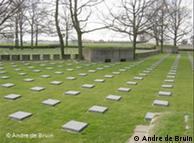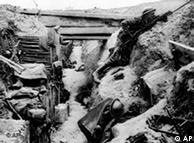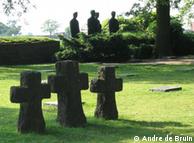EUROPE | 11.11.2010
The German soldiers that history forgot
A bugle will sound across Flanders Fields on Thursday. The Last Post used to mark the end of a day on the battlefields and still today it is played as a haunting reminder of the hundreds of thousands of men who laid down their lives along this stretch of the Western Front during World War I.
Wreaths of blood-red poppies will be laid at the foot of rows upon rows of white headstones in the Commonwealth cemeteries. But one war memorial will remain silent and empty on Armistice Day.
The Langemark cemetery is the final resting place of 44,294 German soldiers. More than half of them are buried in one mass grave, the Kameraden Grab, their names etched on large dark plaques running alongside the site.
"It's a tragedy that hardly anyone comes here. Least of all the Germans themselves, many of whom know very little about what happened," Andre de Bruin, a World War I guide and founder of Over The Top Tours, told Deutsche Welle.
Two million German casualties
 On some of the cemeteries, not even headstones were permitted
On some of the cemeteries, not even headstones were permitted
Andre points to rows of gravestones that lie flat on ground, explaining: "Belgium imposed very strict restrictions on German memorials. Headstones were not allowed to stand, not like those of the Commonwealth soldiers and there were many other rules that applied only to Germans."
There were hundreds of burial sites of German soldiers after 1918 but in the 1950s, Belgium ordered that the bodies be regrouped in no more than four sites, of which Langemark is one.
"It was probably done out of hatred for what happened, especially during World War II when Belgium was occupied. They even forbade the use of crosses above the headstones," de Bruin said.
Germany lost nearly two million men in the First World War, the greatest number of casualties suffered by any nation. Yet for decades, this chapter of history was hardly taught at German schools. Today, the care of German memorials in western Flanders, where some of the bloodiest battle took place, is carried out by a voluntary association, the German War Graves Commission, and its grounds are tended by students.
At the back of Langemark, rain-sodden fields stretch ahead, the same ground that turned into a giant, water-clogged inferno of craters and trenches almost a century ago. It is here that 3,000 German students were killed in 1914.
"They had received just six weeks basic training before they were sent to the front to accompany German soldiers in what was meant to be a triumphant march to victory. But they were all killed in the ensuing battles," Andre explained.
"These men died in the same horrific battles as everyone here and yet on Armistice Day they will lie mostly unremembered," he added.
 Flanders saw some of WWI's bloodiest battles
Flanders saw some of WWI's bloodiest battles
Only few visitors from Germany
Only a tiny number of Germans come to this part of Belgium whereas thousands come from as far away as Australia. A visitors' book at Langemark shows that most visitors are British school children, who visit the site as part of their trips around Ypres.
"We always bring the children here as part of our tours of the World War I sites. We feel that German families mourned their dead just as British or Belgian families would have done," Leonie Giles, a teacher at St Nicholas School in north-west England, told Deutsche Welle.
A colleague added that "the aura here is very different, it's very somber compared to the pristine white cemeteries where the British are buried, which are more like English gardens. But we want our kids to realize that these soldiers were just like the British who died for King and Country."
Simon, a thirteen-year old carrying a small wooden cross with a poppy, said: "It's so vast, that mass grave. And it's such a sad place. I feel very emotional."
Remains of soldiers are still found in this area every year, and these are added to the mass grave. But these days, their burials are done with full military honors and are attended by officials from Germany and Belgium - a sign perhaps that, in time, more recognition will be given to these men who volunteered to lay down their lives.
"Deutschland muss leben auch wenn wir sterben muessen," reads the plaque above their graves. Germany must live even if we must die.
Author: Vanessa Mock, Ypres
Editor: Rob Turner

Comments